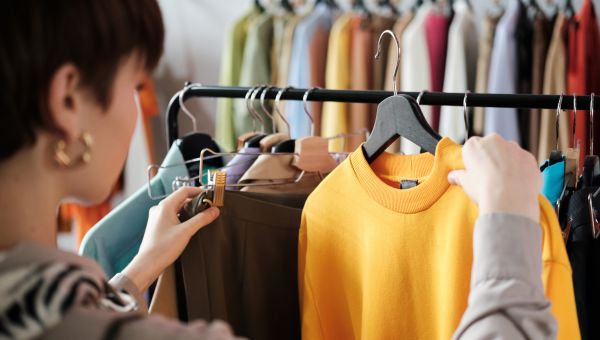5 sneaky ways retailers get you to overspend
Be a smart shopper and beware of these tricks designed to separate you from your money.
Updated on August 1, 2024

Have you ever walked into a store or clicked on a website and come away with much more than you intended to buy? There’s a reason for that.
Holiday retail sales in 2023 hit a record $964.4 billion, including $276.8 billion in online sales. With all that spending going on, every retailer wants a piece of the action—and they’re willing to spend time and money to… Show More
Have you ever walked into a store or clicked on a website and come away with much more than you intended to buy? There’s a reason for that.
Holiday retail sales in 2023 hit a record $964.4 billion, including $276.8 billion in online sales. With all that spending going on, every retailer wants a piece of the action—and they’re willing to spend time and money to figure out how to keep you shopping. Learn some of their tricks, plus smart ways to avoid spending pitfalls.
Show Less
They tempt you to impulse-buy
In the United States, consumers spend an average of $5,400 a year on impulse buys of food, clothing, and household items, according to one estimate. Since there’s a large body of research on the psychology of impulse buying, marketers know how to (quite literally) capitalize on unfocused, in-store… Show More
In the United States, consumers spend an average of $5,400 a year on impulse buys of food, clothing, and household items, according to one estimate. Since there’s a large body of research on the psychology of impulse buying, marketers know how to (quite literally) capitalize on unfocused, in-store shopping. They use techniques like product placement and traffic flow to entice and engage you.
How to keep your hard-earned money: Make a list and stick to it. When you feel the urge to buy an item you weren’t planning to, wait a day or two. You’ll likely find that you can live without it.
Show Less
They follow you around the internet
“Did you ever open up your browser and notice a pair of shoes that you were just looking at advertised on the screen?” asks financial expert Nicole Lapin, author of Miss Independent: A Simple 12-Step Plan to Start Investing and Grow Your Own Wealth. That’s not a coincidence. It’s thanks to cookies.… Show More
“Did you ever open up your browser and notice a pair of shoes that you were just looking at advertised on the screen?” asks financial expert Nicole Lapin, author of Miss Independent: A Simple 12-Step Plan to Start Investing and Grow Your Own Wealth. That’s not a coincidence. It’s thanks to cookies.
Cookies are text files that get downloaded to your computer, tablet, or smartphone that mark you as having visited a site. Websites use these cookies to deliver ads—based on what you’ve viewed—when you move onto other corners of the internet.
How to keep your hard-earned money: Lapin recommends that you regularly clear the cookie cache in your web browser’s settings to help remove the temptation.
Show Less
They pitch savings with in-store credit cards
If a salesperson offers to set you up with a store credit card that offers a percentage off your purchases or the opportunity to earn rewards, don’t be tempted says Lapin. “It’s not much of a good deal,” she says.
According to Bankrate.com, store credit card interest rates had an average 28.… Show More
If a salesperson offers to set you up with a store credit card that offers a percentage off your purchases or the opportunity to earn rewards, don’t be tempted says Lapin. “It’s not much of a good deal,” she says.
According to Bankrate.com, store credit card interest rates had an average 28.93% APR during the 2023 holiday. By comparison, the national average credit card rate was much lower, at 21.19%. And some store cards don’t offer any perks at all.
How to keep your hard-earned money: Say “no thanks” to the pitch at the checkout counter. The amount you would save using the card during a store-wide sale would be miniscule compared to the sky-high interest you would pay on your purchases if you carry a monthly balance.
Show Less
They play the nostalgia card
They play holiday songs to bring back childhood memories, run black-and-white ads evoking a more “wholesome” time, and revive classic brands like the Volkswagen Beetle. Many marketers shoot for a feeling of nostalgia among shoppers. That’s because nostalgia weakens the desire for money. Researchers… Show More
They play holiday songs to bring back childhood memories, run black-and-white ads evoking a more “wholesome” time, and revive classic brands like the Volkswagen Beetle. Many marketers shoot for a feeling of nostalgia among shoppers. That’s because nostalgia weakens the desire for money. Researchers have repeatedly found that when consumers feel nostalgic, they're often willing to pay more for products.
How to keep your hard-earned money: Take off those rose-colored glasses and keep your money in your wallet.
Show Less
They offer misleading holiday ‘bargains’
Black Friday is the traditional kickoff of the holiday shopping season and the biggest shopping day of the year. Retail stores get shoppers through the doors by offering steep discounts. But some of these deals aren’t really deals. Instead, many companies engage in a technique called high-low… Show More
Black Friday is the traditional kickoff of the holiday shopping season and the biggest shopping day of the year. Retail stores get shoppers through the doors by offering steep discounts. But some of these deals aren’t really deals. Instead, many companies engage in a technique called high-low pricing.
In high-low pricing, a product is initially sold at a high price. Later, the retailer lowers the cost through sales, discounts, and other means. After an allotted time has passed, retailers return to the high price. Customers feel like they’re getting a deal, but the retailer still makes the profit they want.
How to keep your hard-earned money: Stuff yourself on Thanksgiving and don’t bother with the crowds on Black Friday. Many of the biggest, most genuine deals are offered a few weeks before then. Keep an eye out for them before the holidays hit.
Show Less
National Retail Federation. NRF Says Census Data Shows 2023 Holiday Sales Grew 3.8% to Record $964.4 Billion. January 17, 2024.
POPAI’S 2014 Mass Merchant Shopper Engagement Study.
Iyer GR, Blut M, Xiao SH et al. Impulse buying: a meta-analytic review. J. of the Acad. Mark. Sci. 48, 384–404; 2020.
Federal Trade Commission. Internet Cookies. Last updated May 2021.
Bankrate. Retail credit card interest rates skyrocket to 28.9% this holiday season, shoppers beware. October 23, 2023.
Weingarten E, Wei Z. Nostalgia and consumer behavior. Curr Opin Psychol. 2023 Feb;49:101555.
Puente-Díaz, R., Cavazos-Arroyo, J., & Awan, U. (2021). Experiential purchases, as memorable moments in consumers’ lives, trigger nostalgia. Cogent Business & Management, 8(1).
Kulczynski, A., & Hook, M. (2024). Typography Talks: Influencing Vintage Anemoia and Product Safety Perceptions with Vintage Typography. Journal of Marketing, 88(4), 129-153.
Lasaleta JD, Sedikides C, Vohs KD. Nostalgia Weakens the Desire for Money. Journal of Consumer Research. Volume 41, Issue 3, 1 October 2014, Pages 713–729.
Suzanne Kapner. The Dirty Secret of Black Friday 'Discounts': How Retailers Concoct 'Bargains' for the Holidays and Beyond. Wall Street Journal. Updated November 25, 2013.
More On


video

article

slideshow


video


video
